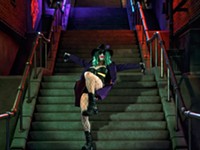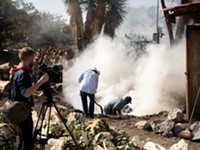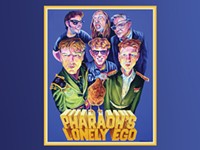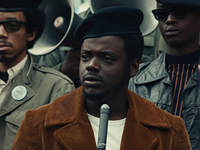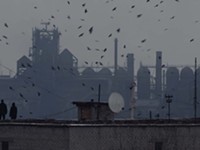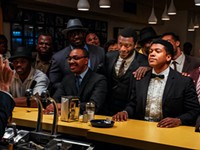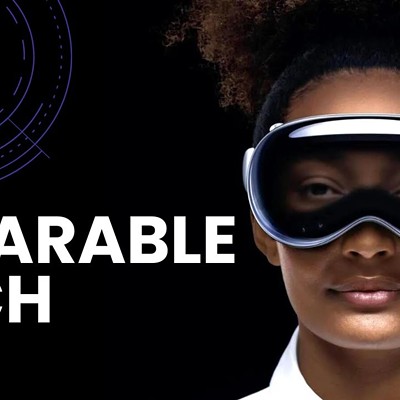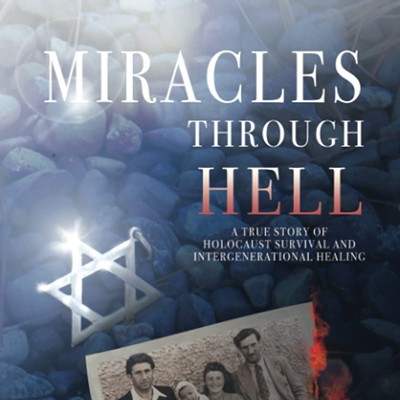[
{
"name": "500x250 Ad",
"insertPoint": "5",
"component": "15667920",
"parentWrapperClass": "",
"requiredCountToDisplay": "1"
}
]
From several of the same twisted minds that created the "V/H/S" trilogy, the new indie horror anthology film "Southbound" resembles what might result from Rod Serling taking a cross-country roadtrip with The Cryptkeeper. Presenting five intertwined "Twilight Zone"-esque morality tales all taking place on the same stretch of lonely desert highway, "Southbound" is a bloody joy ride that should please genre fans and horror enthusiasts alike. You can read City's full review here. "Southbound" is now available On Demand and on iTunes.
City spoke with one of the film's creators, writer-director David Bruckner, to discuss horror's unique ability to let audiences face their darkest fears, the appeal of anthology films, and working with those imaginatively gory effects. An edited transcript of that conversation follows.
City: I'm curious about the collaboration process on these type of anthology-style films. Were there preliminary meetings to get everyone on the same page? How much detail did you know about what the other directors were working on?
David Bruckner: Well, in the past, several of us had worked on the "V/H/S" films -- Radio Silence and myself were on the first "V/H/S," and then Roxanne [Benjamin] and Brad [Miska] produced the first two "V/H/S" movies. For that first movie there was very little communication, we were sent a concept, and then we pitched ideas, and then we all went off and made our own pieces. Many of the shorts were shot in different states altogether. With "V/H/S," I didn't even see the full film assembled until it premiered at Sundance. I didn't really know what we had until it went up.
With "Southbound," we knew we wanted to do something different. We wanted to do something that mimicked a real dramatic structure. And one of the pitfalls of anthology films is that you kind of have to stop and start quite a bit for an audience. It's like when you start a new chapter in a book, and you meet new characters, and for just a second you kind of have to reinvest yourself. The whole story loses momentum. So we'd be talking about it as a five "Act One" kind of problem, and that's a common problem for anthologies. We really wanted to shape the way these pieces related to one another and where one left off and the other picked up the thread. So this one was a very collaborative process.
We all came to the table with various ideas, we went out and drove around the desert, scouted some locations, brainstormed about theme and structure and how the whole thing would work together. So in a sense each story is its own individual creation, led by those writers and directors, but we collaborated a great deal in how they related. And I know oftentimes throughout versions of our drafts or concepts that we wanted to do, we adapted them more into something that would be beneficial to that overall journey.
That collaboration really helps "Southbound" feel much more cohesive than a lot of anthology films. Each story transitions pretty seamlessly into the next. Did you specifically plan out how each story would shift into the next?
It was definitely something that we planned. We kinda knew from the get go that certain concepts that we wanted to do generally lend themselves better to different parts of the story. Like Roxanne's concept with "Sirens" felt like a really great slow burn introduction where you get to know these characters. It really felt like an "Act One" kind of experience to introduce the audience into the world. Whereas Pat [Horvath's] concept -- of a character who kicks in the door of this crazy sort of insidious place, and already sort of understands its designs -- felt very appropriate for something that would come later in the movie, once the audience has grown more accustomed to this world.
As you've mentioned, you've done a few anthology films now. Is there something about this format in particular that you're drawn to?
I love the collaboration, it's a great learning experience for me to just see how other directors work. It's been a little circumstantial that I've ended up doing two, arguably three, of them at this point. Part of it is that they're a little quicker to get made. Sometimes features can be challenging to get into production, so something like this is really great 'cause we were able to just band together and shoot it very quickly.
A lot of the segments play with horror movie tropes: home invasion, satanic rituals, and in your case, a good person desperately trying to fix their one terrible mistake. As a filmmaker, how do you approach taking those familiar elements and giving them a new twist?
I think with horror in particular, it's all about finding that preexisting anxiety, something that the audience can relate to, because most horror tropes are kind of abstractions. They're metaphors for our anxieties and our fears. If you can draw an audience in with something that's extremely familiar -- oftentimes it's just something that we talk about in the writing process: "This is something that scares me; this is something I'm genuinely afraid of. Or this is an area of my life where I don't think I have control. Or this is something that haunts me." And then you either dress that up in a way that's not so obvious to your own life, or you really just run right at it. And that will become an entry point. I think the tropes for me are something that come later. You start to go, "Ok, how do I articulate this? What kind of nightmare is this at the end of the day?"
Watching your sequence in particular, I kept thinking about how there's a pretty thin line between gory horror and slapstick comedy -- in both cases the response is often to cringe and laugh. How do you find the right tone in those scenes?
I think for me, it's kind of funny in the script phase, you know? The clearest way tone was ever explained to me was that it's the attitude of the filmmakers toward the material. So in a sense, if you have a sense of humor about these anxieties, as horrible as they must be, it's like part of the way we cope with it is to find a dark way to laugh at the absurdity. I think that's there from the beginning. I think it's present in the extremity of the writing. It's funny 'cause you pass around the script and a lot of people are reading it and they're going, "Wow, this is..." They'll often comment on the genre stuff that's gonna be intense and scary or whatever it's going to be, and then you'll hear somebody go, "I think it's funny." As though they're uncertain or they're not sure that they have permission to laugh at it. And I feel like that's kind of a sweet spot for me for some reason I'm fond of that.
There's been a bit of a resurgence in the use of practical effects in horror films. You couldn't have directed a film like yours without an appreciation for that art form. Can you explain a little bit about working with those types of effects?
I'm not real experienced in practical effects. I think my job is usually story and getting us to that point -- and I was very nervous about this because there's such a huge effects component. You know, even if there's a sense of humor to the whole thing, I still want what you see to be very, very real. Because there's a tension in that. It's like, "I'm picking up the humor in this, but I also can't unsee what I'm seeing right now and that's very upsetting."
I was very nervous about making sure we could pull it off on a minimal budget, and I was really lucky to find a husband and wife, Josh and Sierra Russell, who saw the opportunities in this and just went crazy with it. I think if it works, it's because of their expertise and lots and lots of preparation. I think audiences are trained to see the line where the real element ends and the fake element begins. Anybody who's ever seen a movie where an actor's pretending like they've lost their hand and you can very clearly see that the arm where the hand is missing is much longer than the other arm. You know, obviously their arm is tucked up into their shirt. We're sort of in tune with those sorts of tricks. We've seen them a whole bunch, so with this we really wanted to make sure that you have a difficult time placing where we've drawn the line, if that makes sense. And oftentimes even though we're focusing on one particular element, we would frame the shot in a very wide way so that you see part of a body moving that troubles your mind. Obfuscating where the effect begins and where it ends.
Larry Fessenden is perfect as the Wolfman Jack-like DJ we hear throughout the film. How did that role come about?
That one was a discovery we made in post. We were stringing the whole movie together and it all worked, but we felt like it was missing something to tie the pieces together. We found ourselves wondering how overt you could get about the themes that were present. It's sort of a fun idea to imagine that it's all just right there on the surface, being broadcast along this highway, and that would be a fun device to play with.
Many of us knew Larry and greatly admire him as a filmmaker and producer and a personality in the indie horror scene, so when he said he'd come on board and voice the DJ for us, it brought so many different elements of the movie together. And I think it plays really wonderfully. I'm still discovering how it fits, and it's a fun flavor to intersperse with the different pieces. I'm still kind of understanding some of what he says in some of the other sections. Upon repeated viewings, it gets funnier and funnier to me.
So many aspects of the film are open ended, from the specifics of what led the characters to the place we find them in, to the location itself -- which feels like Hell or at least a purgatory of some sort. Were there ever any conversations about filling in those details?
Yeah, we definitely had some very specific discussions about what it could be. But if you start answering too many questions, it becomes an exercise in world-building and we wanted to avoid that. One of the fun things about anthology shorts is that you can get in and get out, hopefully without as much explanation, and that leaves it a little more mysterious and a little more scary in a sense. We really want to lean into what you don't know. As far as the writer's room is concerned, those gaps -- those things left unsaid -- I find there's not always a really firm answer for what that is. It's always an evolving answer, so it's a changing thing. Sometimes I'll see the movie and I'll go "you know, this time it occurred to me that maybe it's this. Or maybe where they came from was this." For instance, there's a secret told in the last section, that Radio Silence planted, which we don't hear. I still don't know what it is. Every time I've pressed them about it, I've gotten a different answer. And I think that's part of the fun.
Speaking of...
-

Anomaly film festival review: 'The Columnist'
Nov 13, 2020 -
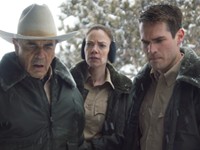
Film review: 'The Wolf of Snow Hollow'
Oct 9, 2020 -
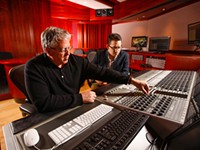
Interview: Beal Institute Director Mark Watters
Jun 27, 2018 - More »

